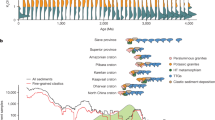Abstract
RECENT work on the experimental granite system1,2 has established a series of quaternary minima shifting in the direction of the NaAlSi3O8 apex with increasing water vapour pressure, and becoming eutectic points at pressures in excess of 3.6 kbars. The “ternary” diagram (Fig. 1) shows the composition of six points at which components simultaneously melt under given isobaric conditions, each of these points representing minimum temperatures on the experimental granite solidus1,2. It is thought that crystallization in the natural granite system, in the presence of volatiles the vapour pressure of which was decreasing, produced trends very similar to those of the experimental system. Field evidence and chemical data3 support this view, and the widespread occurrence of tourmaline, fluorite, and hydrothermally altered granites in Cornubia3,4 suggest that boron and fluorine, together with water vapour, fulfilled the role of volatiles. Because of the higher fluxing action of boron and fluorine compared with water, the shift of the quartz-feldspar boundary towards the albite–orthoclase sideline would be accentuated.
This is a preview of subscription content, access via your institution
Access options
Subscribe to this journal
Receive 51 print issues and online access
$199.00 per year
only $3.90 per issue
Buy this article
- Purchase on Springer Link
- Instant access to full article PDF
Prices may be subject to local taxes which are calculated during checkout
Similar content being viewed by others
References
Tuttle, O. F., and Bowen, N. E., Geol. Soc. Amer. Mem., 74, 153 (1958).
Luth, W. C., Jahns, R. H., and Tuttle, O. F., J. Geophys. Res., 69, 759 (1964).
Booth, B., thesis, Univ. Keele (1966).
Exley, C. S., Quart. J. Geol. Soc. Lond, 114, 197 (1959).
Booth, B., Proc. Ussher Soc., 1, 162 (1965).
Exley, C. S., and Stone, M., Roy. Geol. Soc. Cornwall, Anniversary, Vol. 131 (1964).
Eskola, P., C.R. Soc. Geol. Finlande, No. 7, 12 (1933).
Brammall, A., and Harwood, H. F., Quart. J. Geol. Soc. Lond., 88, 171 (1932).
Booth, B., Proc. Ussher Soc., 1, 212 (1966).
Exley, C. S., Abstr. Proc. Fourth Conf. Geol. Geomorphol. S.W. England (Roy. Geol. Soc. Cornwall, Camborne, 1961).
Author information
Authors and Affiliations
Rights and permissions
About this article
Cite this article
BOOTH, B. Land's End Granites and Their Relation to the Experimental Granite System. Nature 213, 896–897 (1967). https://doi.org/10.1038/213896a0
Received:
Revised:
Published:
Issue Date:
DOI: https://doi.org/10.1038/213896a0
This article is cited by
Comments
By submitting a comment you agree to abide by our Terms and Community Guidelines. If you find something abusive or that does not comply with our terms or guidelines please flag it as inappropriate.



